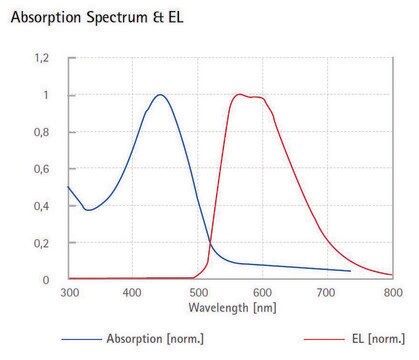541435
Poly[2-methoxy-5-(2-ethylhexyloxy)-1,4-phenylenevinylene]
average Mn 70,000-100,000
Synonyme(s) :
Poly[2-methoxy-5-(2-ethylhexyloxy)-1,4-phenylenevinylene], MEH-PPV
About This Item
Produits recommandés
Description
Band gap: 2.3 eV
Poids mol.
average Mn 70,000-100,000
Fluorescence
λex 495 nm; λem 554 nm in toluene
Énergie orbitale
HOMO -5.3 eV
LUMO -3 eV
Performance des dispositifs OLED
ITO/PEDOT:PSS/MEH-PPV/Al
ITO/PEDOT:PSS/MEH-PPV/PBO/Al
ITO/PEDOT:PSS/MEH-PPV/PBZT/Al
Performance des dispositifs OPV
ITO/MEH-PPV/BBL/Al
ITO/MEH-PPV:PC61BM(1:4)/Ca
Température de stockage
2-8°C
Vous recherchez des produits similaires ? Visite Guide de comparaison des produits
Description générale
Application
Filter before application.
Code de la classe de stockage
11 - Combustible Solids
Classe de danger pour l'eau (WGK)
WGK 3
Point d'éclair (°F)
Not applicable
Point d'éclair (°C)
Not applicable
Équipement de protection individuelle
Eyeshields, Gloves, type N95 (US)
Faites votre choix parmi les versions les plus récentes :
Déjà en possession de ce produit ?
Retrouvez la documentation relative aux produits que vous avez récemment achetés dans la Bibliothèque de documents.
Articles
The development of high-performance conjugated organic molecules and polymers has received widespread attention in industrial and academic research.
Light-Emitting Polymers
Professor Chen (Nankai University, China) and his team explain the strategies behind their recent record-breaking organic solar cells, reaching a power conversion efficiency of 17.3%.
Notre équipe de scientifiques dispose d'une expérience dans tous les secteurs de la recherche, notamment en sciences de la vie, science des matériaux, synthèse chimique, chromatographie, analyse et dans de nombreux autres domaines..
Contacter notre Service technique![Poly[2-methoxy-5-(2-ethylhexyloxy)-1,4-phenylenevinylene] average Mn 40,000-70,000](/deepweb/assets/sigmaaldrich/product/structures/344/488/b8f8179d-3970-4deb-a754-adda88cdb36f/640/b8f8179d-3970-4deb-a754-adda88cdb36f.png)


![Poly[(9,9-di-n-octylfluorenyl-2,7-diyl)-alt-(benzo[2,1,3]thiadiazol-4,8-diyl)] average Mn ≤25000](/deepweb/assets/sigmaaldrich/product/structures/428/661/1c4ebb98-9d51-48c0-96c7-e556ca425aa4/640/1c4ebb98-9d51-48c0-96c7-e556ca425aa4.png)
![Poly[9,9-bis-(2-ethylhexyl)-9H-fluorene-2,7-diyl] light-emitting λem 409 nm (in chloroform)](/deepweb/assets/sigmaaldrich/product/structures/186/919/a69a261c-1d02-44b4-82ab-119ad6c9d843/640/a69a261c-1d02-44b4-82ab-119ad6c9d843.png)

![Poly[(m-phenylenevinylene)-co-(2,5-dioctoxy-p-phenylenevinylene)] light-emitting polymer, predominantly trans](/deepweb/assets/sigmaaldrich/product/structures/249/040/9442b889-4fa0-4b4a-b424-cff0769a5ef2/640/9442b889-4fa0-4b4a-b424-cff0769a5ef2.png)

![Poly[(p-phenylenevinylene)-alt-(2-methoxy-5-(2-ethylhexyloxy)-p-phenylenevinylene)]](/deepweb/assets/sigmaaldrich/product/structures/147/963/61b421da-530b-4acf-8851-ecb9492e90ba/640/61b421da-530b-4acf-8851-ecb9492e90ba.png)
![Poly[5-methoxy-2-(3-sulfopropoxy)-1,4-phenylenevinylene] potassium salt solution 0.25 wt. % in H2O](/deepweb/assets/sigmaaldrich/product/structures/111/584/9e24dfe5-3cb6-4bd8-8bc6-cbe82c1b88cd/640/9e24dfe5-3cb6-4bd8-8bc6-cbe82c1b88cd.png)